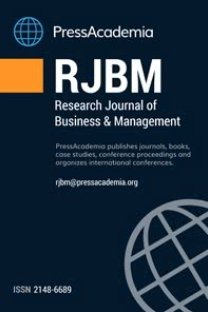THE VOLATILITY SPILLOVER BETWEEN NFT INVESTMENT INDEX AND GLOBAL TECHNOLOGY INDEX: DCC-GARCH APPLICATION
THE VOLATILITY SPILLOVER BETWEEN NFT INVESTMENT INDEX AND GLOBAL TECHNOLOGY INDEX: DCC-GARCH APPLICATION
Purpose- NFT is a digital token that represents a unique, one-of-a-kind asset on the blockchain. In this respect, NFTs can be used to represent ownership of any unique asset. In this study, the volatility spillover relationship between the NFT Investment Index and the Global Technology Index (XTEC) is investigated. Methodology- More than one GARCH type model has been developed that reveals the relationship between assets in financial markets. The DCC GARCH model was preferred because it is a current model that reveals the variable correlation coefficient depending on time. The DCCGARCH method was preferred for modeling the volatility spillover in the study. Daily data covering the period 19.04.2021-22.04.2022 are used. Findings- - According to the findings of the study; A mutual volatility spillover has been detected between the NFT Investment Index and XTEC. Accordingly, the 1% shock in XTEC increases the NFT Investment Index volatility by 0.24%, while the 1% shock in the NFT Investment Index increases the XTEC volatility by approximately 1.86%. The findings show that NFT Investment Index volatility is more effective on XTEC volatility. Conclusion- Those who invest in NFT or technology markets and those who are considering investing should also take into account the developments in the other market in question in terms of risk management. In addition, market regulators should take a proactive approach by considering the impact and importance of NFT markets.
Keywords:
Blockchain crypto assets, DCC-GARCH model, Non-Fungible Token (NFT),
___
- Alawadhi, K. M. & Alshamali, N. (2022). NFTs Emergence in Financial Markets and their Correlation with DeFis and Cryptocurrencies. Applied Economics and Finance, 9(1), 108-120.
- Ante, L. (2021). The Non-Fungible Token (NFT) Market and Its Relationship with Bitcoin and Ethereum. Blockchain Research Lab, BRL Working Paper Series No. 20.
- Bao, H., & Roubaud, D. (2022). Non-Fungible Token: A Systematic Review and Research Agenda. Journal of Risk and Financial Management, 15(5), 215. https://www.mdpi.com/1911-8074/15/5/215 (Date Accessed: 29.05.2022).
- Binance Academy (2020). Kripto Koleksiyonlukları ve Benzersiz Tokenler (NFT) Rehberi. https://academy.binance.com/tr/articles/a-guide-tocrypto-collectibles-and-non fungible-tokens-nfts (Date Accessed: 24.05.2022).
- Binance Academy (2021). Kendi NFT’lerinizi Nasıl Üretebilirsiniz? https://academy.binance.com/tr/articles/how-to-make-your-own-nfts (Date Accessed: 24.05.2022).
- Bollerslev, T. (1990). Modelling the Coherence in Short-Run Nominal Exchange Rates: A Multivariate Generalized ARCH Model. The Review of Economics and Statistics, 72(3), 498-505.
- Bollerslev, T., Engle, R. F. & Wooldridge, J. M. (1988). A Capital Asset Pricing Model with Time-Varying Covariances. Journal of Political Economy, 96(1), 116–131.
- Diebold, F. X. & Yilmaz, K. (2012). Better to Give than to Receive_Predictive Directional Measurement of Volatility Spillover. International Journal of Forecasting, 28(1), 57-66.
- Dowling, M. (2022a). Fertile LAND: Pricing Non-Fungible Tokens. Finance Research Letters, 44, 102096.
- Dowling, M. (2022b). Is Non-Fungible Token Pricing Driven by Cryptocurrencies? Finance Research Letters, 44, 102097.
- Engle, R. (2002). Dynamic Conditional Correlation: A Simple Class of Multivariate Generalized Autoregressive Conditional Heteroskedasticity Models. Journal of Business & Economic Statistics, 20(3), 339–350.
- Engle, R. F. & Kroner, K. F. (1995). Multivariate Simultaneous Generalized ARCH. Econometric Theory, 11(1), 122-150.
- Gul Senkardes, C. (2021). Blockchain Technology and NFT’s: A Review in Music Industry. Journal of Management, Marketing and Logistics (JMML), 8(3), 154-163
- Güven, V. & Şahinöz, E. (2018). Blokzincir - Kripto Paralar - Bitcoin: Satoshi Dünyayı Değiştiriyor. İstanbul: Kronik Kitap.
- Han, H., Linton, O., Oka, T., & Whang, Y. J. (2016). The Cross Quantilogram: Measuring Quantile Dependence and Testing Directional Predictability between Time Series. Journal of Econometrics, 193(1), 251-270.
- Hepsağ, A. & Akçalı, B. Y. (2016). Türk Finans Piyasasında İşlem Gören Bankalar İle ABD Finans Piyasası Arasındaki Volatilite Etkileşiminin Analizi. Avrasya Ekonometri İstatistik ve Ampirik Ekonomi Dergisi, 1(1), 54-72.
- Ito, K., Shibano, K. & Mogi, G. (2022). Predicting the Bubble of Non-Fungible Tokens (NFTs): An Empirical Investigation. https://arxiv.org/abs/2203.12587 (Date Accessed: 26.05.2022).
- NonFungible.com (2022). NFT Market Quarterly Report: Q1 · 2022. https://nonfungible.com/reports/2022/en/q1-quarterly-nft-marketreport-free/thank-you (Date Accessed: 29.05.2022).
- Pinto-Gutiérrez, C., Gaitán, S., Jaramillo, D. & Velasquez, S. (2022). The NFT Hype: What Draws Attention to Non-Fungible Tokens? Mathematics, 10(3), 1-13.
- Sattary, A. (2014). Petrol Fiyatları İle Hisse Senedi Getirileri Arasında Oynaklık Geçişkenliğinin Analizi Ve Portföy Yönetimine Yansımaları. Yayımlanmamış Doktora Tezi. Atatürk Üniversitesi Sosyal Bilimler Enstitüsü, Ekonometri Anabilim Dalı.
- Tse, Y. & Tsui, A. (2002) A Multivariate GARCH Model with Time-Varying Correlations. Journal of Business and Economic Statistics, 20, 351- 362.
- www.ethereum.org/en/nft/ (Date Accessed: 25.05.2022).
- www.investing.com (Date Accessed: 25.04.2022).
- Yousaf, I. & Yarovaya, L. (2022) Static and Dynamic Connectedness between NFTs, Defi and Other Assets: Portfolio Implication. Global Finance Journal, 53, 100719
- Yayın Aralığı: Yılda 4 Sayı
- Başlangıç: 2014
- Yayıncı: PressAcademia
